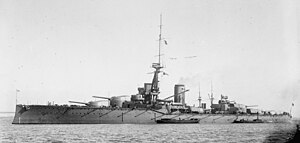Orion-class battleship

HMS Monarch
|
|
| Class overview | |
|---|---|
| Name: | Orion-class battleship |
| Operators: |
|
| Preceded by: | Colossus class |
| Succeeded by: | King George V class |
| In commission: | 1912–22 |
| Completed: | 4 |
| General characteristics | |
| Type: | Super-dreadnought battleship |
| Displacement: |
|
| Length: | 581 ft (177.1 m) |
| Beam: | 88 ft (26.8 m) |
| Draught: | 24 ft (7.3 m) |
| Propulsion: | Direct-drive steam turbines, 18 boilers, 4 shafts: 27,000 hp (20 MW) |
| Speed: | 21 knots (38.9 km/h) |
| Range: | 6,730 nm at 10 knots (12,450 km at 18.5 km/h) |
| Complement: | 750–1100 |
| Armament: |
|
| Armour: | |
The Orion-class battleships were four super-dreadnought battleships—the first ships of that type—of the Royal Navy. The lead ship, Orion, was launched in 1910. They were the first Royal Navy dreadnoughts to have all their main guns in the centreline; the U.S. Navy's first dreadnoughts, the South Carolina class, had pioneered this advanced feature. The Orions were quite distinct from the later classes of 13.5-inch gun super-dreadnoughts (the King George Vs and Iron Dukes) in that the foremast was placed behind the forefunnel. This arrangement was common in early Royal Navy dreadnoughts but created major problems for the gunnery direction team in the spotting top.
Previous British dreadnoughts had been built very much with an eye on cost. By 1909, the escalating Anglo-German naval arms race had released greatly increased resources from the British treasury. These ships were much bigger than the preceding Colossus class and cost almost £1.9 million each to construct.
The move to the 13.5-inch (343 mm) gun came out of necessity. The final iteration of the 12-inch (305 mm), the high velocity 50 calibre long Mark XI, had been unsuccessful. It lost some of its accuracy and was subject to considerable bore erosion that limited its useful life to about 80 discharges. A lower velocity weapon was indicated, and this was realized in the 13.5-inch, 45 calibres long, and with a much heavier projectile. The projectile used was 1,250 lb (567 kg) or 1,400 lb (635 kg) against 850 lb (386 kg). The shorter range of the low-velocity gun was compensated by increasing the maximum elevation from 15 to 20 degrees. The 13.5-inch was considered a successful design, although its effectiveness was compromised by poor shell design until availability of the "Green Boy" shells in 1918.
The adoption of the all-centreline armament was also born of necessity. The previous Colossus and Neptune classes had already adopted a superfiring pair of turrets aft in an effort to save deck space, and competing designs in the U.S. and elsewhere had led the way in the all-centreline arrangement. From a combat efficiency standpoint the staggered turret configuration of the Colossuses and Neptunes complicated internal arrangements and was generally not considered a success. Unfortunately, the retention of outdated sighting hoods meant the Orions were not able to fire the superimposed turrets over the deck turrets for fear that the blast would injure crews in the lower turrets. Also, the design's relatively high centre of gravity gave the Orions a pronounced roll in rough seas. Both these defects were eventually cured and the improvements included in subsequent classes of British dreadnoughts.
...
Wikipedia
